The SSD Diaries: Crucial's RealSSD C300
by Anand Lal Shimpi on July 13, 2010 12:39 AM ESTOverall System Performance using PCMark Vantage
Next up is PCMark Vantage, another system-wide performance suite. For those of you who aren’t familiar with PCMark Vantage, it ends up being the most real-world-like hard drive test I can come up with. It runs things like application launches, file searches, web browsing, contacts searching, video playback, photo editing and other completely mundane but real-world tasks. I’ve described the benchmark in great detail before but if you’d like to read up on what it does in particular, take a look at Futuremark’s whitepaper on the benchmark; it’s not perfect, but it’s good enough to be a member of a comprehensive storage benchmark suite. Any performance impacts here would most likely be reflected in the real world.
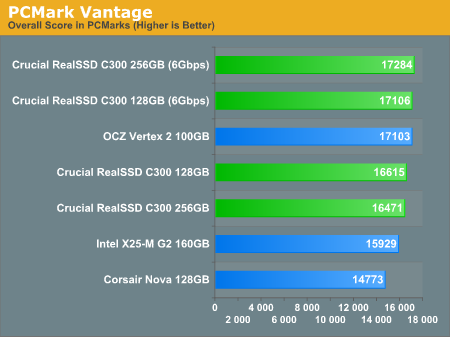
The overall PCMark vantage score puts the OCZ Vertex 2 ahead of the C300 by only 3%. Move to a 6Gbps controller and the C300 is now on par with the Vertex 2. Either way you look at it, general desktop performance should be about the same between the two for workloads exemplified by PCMark Vantage. The real world advantage over the Corsair Nova is 12.5%, just enough to be noticeable. This also reflects what I’ve seen in my own experiences with these drives as a user. There’s a noticeable performance increase between the X25-M/Indilinx class of SSDs and the new guard. It’s not earth shattering, and no where near the gap you see between SSDs and HDDs, but it’s noticeable on fast systems.
The memories suite includes a test involving importing pictures into Windows Photo Gallery and editing them, a fairly benign task that easily falls into the category of being very influenced by disk performance.
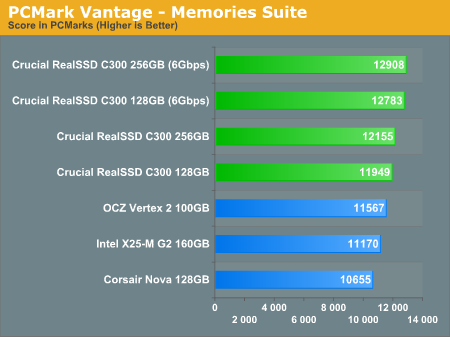
The TV and Movies tests focus on on video transcoding which is mostly CPU bound, but one of the tests involves Windows Media Center which tends to be disk bound.

The gaming tests are very well suited to SSDs since they spend a good portion of their time focusing on reading textures and loading level data. All of the SSDs dominate here, but as you'll see later on in my gaming tests the benefits of an SSD really vary depending on the game. Take these results as a best case scenario of what can happen, not the norm.
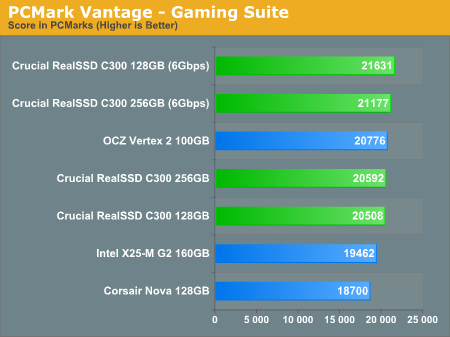
In the Music suite the main test is a multitasking scenario: the test simulates surfing the web in IE7, transcoding an audio file and adding music to Windows Media Player (the most disk intensive portion of the test).
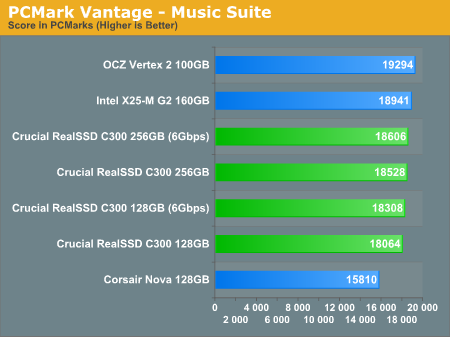
The Communications suite is made up of two tests, both involving light multitasking. The first test simulates data encryption/decryption while running message rules in Windows Mail. The second test simulates web surfing (including opening/closing tabs) in IE7, data decryption and running Windows Defender.
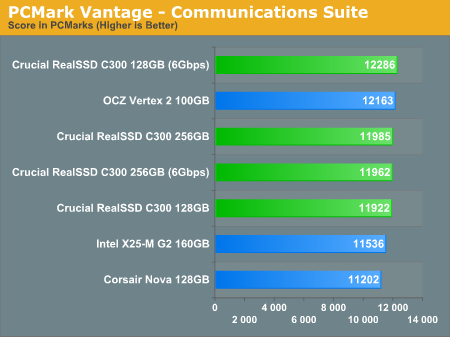
I love PCMark's Productivity test; in this test there are four tasks going on at once, searching through Windows contacts, searching through Windows Mail, browsing multiple webpages in IE7 and loading applications. This is as real world of a scenario as you get and it happens to be representative of one of the most frustrating HDD usage models - trying to do multiple things at once. There's nothing more annoying than trying to launch a simple application while you're doing other things in the background and have the load take forever.

The final PCMark Vantage suite is HDD specific and this is where you'll see the biggest differences between the drives:
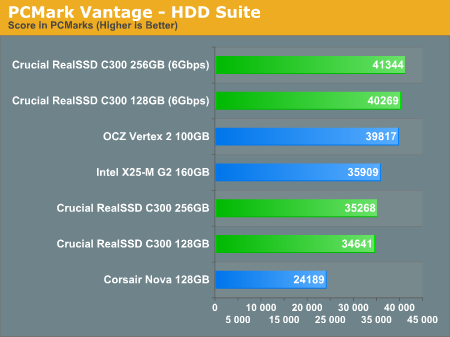
In the HDD suite itself, OCZ holds the clear advantage with the Vertex 2 showing up 15% faster than the 128GB RealSSD C300. Moving to a 6Gbps interface basically levels the playing field between the two.










51 Comments
View All Comments
fgmg2 - Tuesday, July 13, 2010 - link
I know that I could flip back and forth between the various charts to calculate the performance per a watt, but it be great to get a consolidated chart that graphed the drives based upon write (read?) performance per a watt.Additionally analyzing drives purely based upon their write/read performance and/or purely based upon their power consumption seems a bit meaningless. It should be very easy to make a drive consumes almost no power but writes slower than a 3 1/2" floppy. Especially as you see some drives perform more than twice as fast as others.
Just a suggestion.
P.S. It might not be a bad idea to do the same for your other reviews, such as video cards and CPUs.
7Enigma - Tuesday, July 13, 2010 - link
Agreed. In most reviews (video cards for example) performance per watt is somewhat less important as normally you'll be modeling or gaming and the power draw is going to be pretty stable.But for a hard drive, especially when many of these will be notebook replacements, it is very important. I have an Intel G2 80GB and love it, and when I look at the power consumption numbers it looks better than the C300. But I'm not naive to the fact that (when TRIM'd) the C300 crushes the G2 in pretty much every benchmark. What that tells me is that in a real-world result the C300 would use more power but get the job done in a shorter time and since we aren't spinning up a traditional platter, the HD behaves very much like a modern Intel CPU and would go idle.
That hurry up and get idle I think would skew those power consumption charts heavily.
What I would design would be a benchmark that has a set instruction set (write 2GB of random, 2 GB of sequential, read 10GB of data), and then measure the TOTAL power of the drive consumed during that time. Then report that total power number and use it for future reviews (a static number to rank similar to a PCMark or Vantage score)
Ernestds - Tuesday, July 13, 2010 - link
I think the best way to calculate efficiency is measuring the total energy used by the drive doing the "Typical Workload" test. Of course, if Anand could do the same with the "Heavy Downloading Workload" it would be great. IMO there is no need for the "Gaming Workload" though, usually who looks for the power graphs is aiming the improvness(does this word exist?) of a notebook's battery life, and frequently who cares about that, do not game on battery.Just a question to Anand, do you feel difference between two SSDs, say the Nova one and the Crucial?
Keep on the great work!
MrSpadge - Tuesday, July 13, 2010 - link
It's kind of funny to see someone asking for power efficiency for something which is probably the most power efficient thing in the entire PC, especially if you compare it to HDDs. I understand it's interesting and maybe even important for laptops, though.I'd rather be interested in more detailed power draw and/or efficiency analysis in case where the power draw really hurts: GPUs and to a lesser extent CPU. For example: how does the power draw of a GF100 improve under load if you watercool it? Sure, not very relevant for most users.. but the difference should be surprisingly large.
shin0bi272 - Tuesday, July 13, 2010 - link
If you want best overall performance go sandforce. The only real large advantage the crucial drive had was in read performance. sysmark et al were within a few hundred points of one another. So the overall feel of the system will be identical till you either do some heavy read ops or conversely you fill the drive and dont trim it. With the prices being about the same for the 100 vs 128 the better performer is the sandforce drives.Techdad - Tuesday, July 13, 2010 - link
Really? You'd take the performance tricks and the risk of real data that doesn't fit SandFarce's fancy algorithms over the straight honest performance of the Crucial drive? That's odd.I've had my Crucial drive since it came out and it's been great. In spite of Anand's corner-case bashing the first version firmware has been rock solid. Debating even if I want to bother with the firmware upgrade, but I'll probably do it.
bji - Tuesday, July 13, 2010 - link
Relying on TRIM and optimizing for the least stressful case is also a "performance trick", so your implication that Sandforce uses such tricks and Micron does not is wrong. Also your childish pun on the Sandforce name shows alot about where you are coming from.The Sandforce and the Micron drives look to have very similar performance in the vast majority of cases, so shin0bi272 is spot-on. And the increased cost of the Crucial drive would seem to be the deciding factor for me.
But you can't go wrong with either offering it would seem, so pick whichever you like best. As for myself, I would pick Sandforce, only because of my extreme aversion to any chance of degraded drive performance, having been bitten by stuttering of early drives. Not saying that the Crucial drive is anything like a JMicron, but I personally value the resiliency of the Sandforce controller very highly, and would pay some peak performance cost happily for the guarantee of better worst-case performance.
Not everyone will, or should, have the same opinion on this; those less averse to the risks of worst-case performance degredation would be well served by the Crucial drive.
hotlips69 - Tuesday, July 13, 2010 - link
Having read this review, I'm considering buying one of the 100GB "OCZ Vertex 2" drives used in this article, but I'm not sure exactly which is the correct drive model as there seem to be numerous "Vertex 2" drives on the OCZ website!!Is it the Pro Series or EX Series or just the standard Vertex 2 series???
hotlips69 - Tuesday, July 13, 2010 - link
....also, why is it listed as 120GB in the chart on page 1 of the article?Anand Lal Shimpi - Tuesday, July 13, 2010 - link
A standard Vertex 2 120GB drive is all you need. The 100GB capacities will probably be phased out by most SandForce partners over time as there's no tangible performance benefit for desktop workloads.I just used the 100GB data we had in the engine which is why it appears as such in the charts.
Take care,
Anand